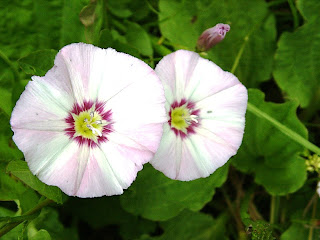This blog may help people explore some of the 'hidden' issues involved in certain media treatments of environmental and scientific issues. Using personal digital images, it's also intended to emphasise seasonal (and other) changes in natural history of the Swansea (South Wales) area. The material should help participants in field-based modules and people generally interested in the natural world. The views are wholly those of the author.
Saturday, 3 July 2010
Seeing the Changes 308
In Loughor, Tormentil (Potentilla erecta), Field bindweed (Convolvulus arvensis), Black nightshade (Solanum nigrum), Butterfly bush (Buddleja davidii) and Prickly lettuce (Lactuca serriola) were in flower. There were lots of Ringlet (Athantopus hyperantus) and Meadow brown (Maniola jurtina) butterflies, mating Flesh-flies (Sarcophaga carnaria), a Sawfly (Tenthredo celtica), Common froghoppers (Philaenus spumarius), maternal spiders with creche webs and a Scorpion fly (Panorpa communis). The house was invaded by a female Crab spider (Misumena vatia). In Penclacwydd, the Hazel (Corylus avellana) was in nut and Water-pepper (Polygonum hydropiper) plus Marsh bedstraw (Galium palustre) were in bloom. Bittersweet (Solanum dulcamara) had green berries. In Bynea, masses of Great willowherb (Epilobium hirsutum), Blue fleabane (Erigeron acer), Wild carrot (Daucus carota), Alexanders (Smyrnium olusatrum) and Common orache (Atriplex patula) were in flower. Summer broods of the Comma (Polygonia c-album) and Red admiral (Vanessa atalanta) butterflies were seen there.
Subscribe to:
Post Comments (Atom)
-
I n the UK and US, a pparently popular and successful vegan/vegetarian restaurants are reportedly closing or adding meat to their menus ( ...
-
Early ripening fruit may seem convenient but some folk think it confirms environmental stress. There's also a possibility th...
+dorsal+on+Butterfly+bush+Bynea.JPG)
























%20mating%20NWCW.jpg)


No comments:
Post a Comment